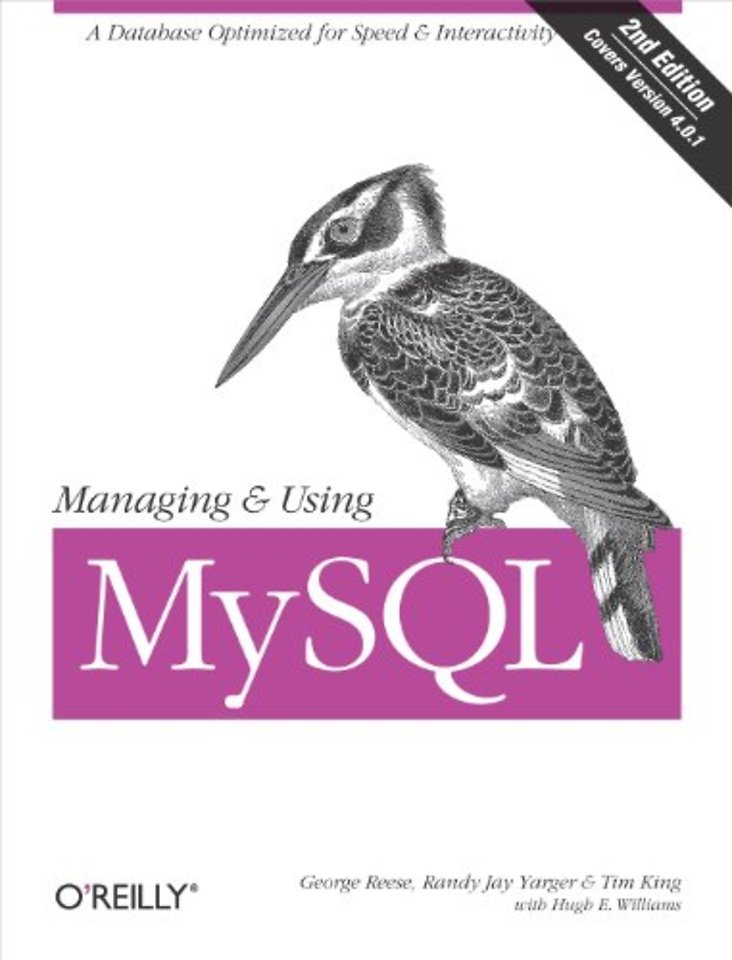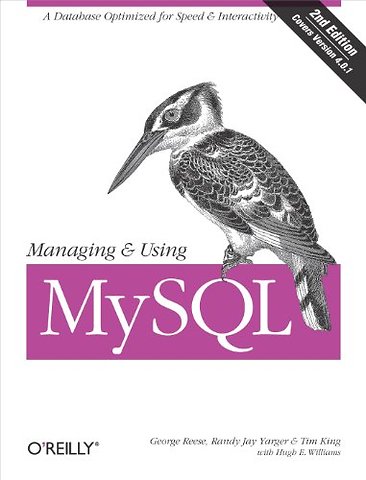Managing & Using MySQL 2e
Samenvatting
MySQL is a popular and robust open source database product that supports key subsets of SQL on both Linux and Unix systems. MySQL is free for nonprofit use and costs a small amount for commercial use. Unlike commercial databases, MySQL is affordable and easy to use. This book includes introductions to SQL and to relational database theory. If you plan to use MySQL to build web sites or other Linux or Unix applications, this book teaches you to do that, and it will remain useful as a reference once you understand the basics. Ample tutorial material and examples are included throughout.
This book has all you need to take full advantage of this powerful database management system. It takes you through the whole process from installation and configuration to programming interfaces and database administration. This second edition has a greatly enhanced administration chapter that includes information on administrative tools, server configuration, server startup and shutdown, log file management, database backup and restore, and database administration and repair. In addition, a new chapter on security describes data, server, and client-server security, while a chapter on extending MySQL provides an overview of MySQL internals and describes the use of MySQL user-defined functions.
If you know C/C++, Java, Perl, PHP, or Python, you can write programs to interact with your MySQL database. In addition, you can embed queries and updates directly in an HTML file so that a web page becomes its own interface to the database. Managing and Using MySQL includes chapters on the programming language interfaces, and it also includes a complete reference section with specific function calls for each language.
Also included in the reference section are references to the SQL language, and details of the MySQL system variables, programs, and utilities. New to the second edition is a reference to the internal MySQL tables, which will be of particular interest to those who want to work extensively with MySQL security.
Specificaties
Inhoudsopgave
Audience;
Purpose;
Using This Book;
Conventions Used in This Book;
Comments and Questions;
Acknowledgments;
Part I: Introduction;
Chapter 1: MySQL;
1.1 Relational Databases;
1.2 The History of MySQL;
1.3 MySQL Design;
1.4 MySQL Features;
1.5 MySQL Applications;
1.6 What You Get;
Chapter 2: Installation;
2.1 Preparation;
2.2 Unix Installation;
2.3 Windows Installation;
Chapter 3: SQL According to MySQL;
3.1 SQL Basics;
3.2 Database Creation;
3.3 Table Management;
3.4 MySQL Data Types;
3.5 Indexing;
3.6 Managing Data;
3.7 Queries;
3.8 SQL Operators;
3.9 Advanced Features;
Chapter 4: Database Administration;
4.1 Configuration;
4.2 Server Startup and Shutdown;
4.3 Logging;
4.4 Backup;
4.5 Recovery;
4.6 Table Maintenance and Crash Recovery;
Part II: MySQL Administration;
Chapter 5: Performance Tuning;
5.1 An Approach to Performance Tuning;
5.2 Application Tuning;
5.3 Database Server Tuning;
5.4 Operating System/Hardware Tuning;
Chapter 6: Security;
6.1 Database Security;
6.2 System Security;
6.3 Application Security;
Chapter 7: Database Design;
7.1 Database Design Primer;
7.2 Normalization;
7.3 A Logical Data-Modeling Methodology;
7.4 Physical Database Design;
Part III: MySQL Programming;
Chapter 8: Database Applications;
8.1 Architecture;
8.2 Connections and Transactions;
8.3 Object/Relational Modeling;
Chapter 9: Perl;
9.1 Introduction to DBI;
9.2 DBI and CGI;
9.3 A General Model for Maintainable Perl Programs;
Chapter 10: Python;
10.1 DB-API;
10.2 Proprietary Operations;
10.3 Applied DB-API;
Chapter 11: PHP;
11.1 Introducing PHP;
11.2 Installing PHP;
11.3 Accessing the MySQL DBMS with PHP;
11.4 Securing User Data;
11.5 Managing Sessions;
11.6 Writing Data with PHP;
11.7 Using the HTML <form> Environment;
11.8 Where to Find Out More;
Chapter 12: C API;
12.1 API Overview;
12.2 The C API in Practice;
12.3 Advanced Issues;
Chapter 13: Java;
13.1 The JDBC API;
13.2 Simple Database Access;
13.3 Dynamic Database Access;
13.4 A Guest Book Servlet;
Chapter 14: Extending MySQL;
14.1 User-Defined Functions;
14.2 Alternative Character Sets;
Part IV: MySQL Reference;
Chapter 15: SQL Syntax for MySQL;
15.1 Basic Syntax;
15.2 SQL Commands;
Chapter 16: MySQL Data Types;
16.1 Numeric Data Types;
16.2 String Data Types;
16.3 Date Data Types;
16.4 Complex Data Types;
Chapter 17: Operators and Functions;
17.1 Operators;
17.2 Functions;
Chapter 18: MySQL PHP API Reference;
18.1 Data Types;
18.2 Functions;
Chapter 19: C Reference;
19.1 Data Types;
19.2 Functions;
Chapter 20: The Python DB-API;
20.1 Module: MySQLdb;
Colophon;
Net verschenen
Rubrieken
- aanbestedingsrecht
- aansprakelijkheids- en verzekeringsrecht
- accountancy
- algemeen juridisch
- arbeidsrecht
- bank- en effectenrecht
- bestuursrecht
- bouwrecht
- burgerlijk recht en procesrecht
- europees-internationaal recht
- fiscaal recht
- gezondheidsrecht
- insolventierecht
- intellectuele eigendom en ict-recht
- management
- mens en maatschappij
- milieu- en omgevingsrecht
- notarieel recht
- ondernemingsrecht
- pensioenrecht
- personen- en familierecht
- sociale zekerheidsrecht
- staatsrecht
- strafrecht en criminologie
- vastgoed- en huurrecht
- vreemdelingenrecht

